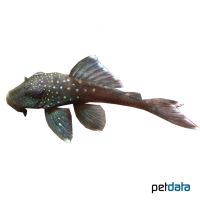Blue Phantom Pleco L128 (Hemiancistrus sp. 'L128')
| Blue Phantom Pleco L128 Hemiancistrus sp. 'L128' | |
|---|---|
| Name | Blue Phantom Pleco L128 |
| Name Lat. | Hemiancistrus sp. 'L128' |
| Family | Suckermouth Armoured Catfishes |
| Family lat. | Loricariidae |
| Order | Catfishes |
| Order lat. | Siluriformes |
| Origin | Venezuela |
| Habitat | Rivers |
| Diet | Omnivore, soft wood |
| pH | 6.5-7.5 |
| Behavior | Nocturnal, peaceful |
| Keeping | Individual, pair, group |
| Care Level | Moderate |
| Reproduction | Cave spawner |
| Breeding | Difficult |
| Life Span | 8-10 years |
| Protection | No |
| Metric Units | |
| Size | 18 cm |
| Temperature | 25-29 °C |
| Hardness | 2-12 °dH |
| Aquarium | ~ 300 l |
| US Units | |
| Size | 7" |
| Temperature | 77-84 °F |
| Hardness | 36-214 ppm |
| Aquarium | ~ 80 gal |
Distribution and habitat
The crepuscular to nocturnal Blue Phantom Catfish L128 are found in the Rio Orinoco watershed between Puerto Carreno in Colombia and Puerto Ayacucho in Venezuela. They live in flowing waters, where they often stay in the current between and under stones.
Maintenance
The aquarium should have a robust border planting with stones, caves (catfish burrows) and roots, which provide hiding places and at the same time are part of the food. A substrate of sand and round-grained gravel, subdued light (floating plant cover) and a medium current is ideal.
No ammonia, ammonium and nitrite should be detectable, the nitrate value should not exceed 100 mg/l. To ensure the water quality and oxygen content, a filter and heater adapted to the aquarium size is required, as well as lighting for the species-appropriate day-night rhythm of the animals.
Diet
They feed on plant and animal food. For a balanced diet, feed once a day with a high-quality dry food for loricariid catfish (granules, pellets, chips, tablets), supplemented with algae leaves, soft wood and fresh vegetables, such as zucchini, broccoli, bruised peas, scalded spinach, as well as zoopankton, cyclops, daphnia, artemia, mosquito larvae, shrimp, etc. (live or frozen)
Feed only as much as will be eaten within a few minutes, excluding plant foods. Regular and varied feeding promotes health and increases resistance.
Behaviour and compatibility
They are calm, peaceful catfish that are somewhat territorial only during spawning season and are very suitable for a community tank with other calm fish. It is recommended to keep them in pairs or in a group of 3-5.
Basically, only compatible fish species with similar demands on water conditions and water temperature should be socialized.
Sex dimorphism
Sexually mature males possess significantly longer gill cover spines (interopercular odontodes) and have much greater odontode growth on the first pectoral fin hard ray than females.
Reproduction and breeding
The breeding in the aquarium has already succeeded several times. They are cave breeders and the male does the brood care.
Important
There are several site variants that differ in basic coloration as well as in size, number and arrangement of spots on the body
They have a strong sucking mouth, with spoon-shaped teeth for scraping wood and an intestinal flora that allows the fish to digest the cellulose.
When fishing, use the finest mesh nets possible to prevent the hard rays of the pectoral fins or the skin teeth (odontodes) from getting caught on the bone plates, which can cause painful puncture wounds when touched.
The well-being of the fish should be checked regularly. Temperature should be checked daily, pH, hardness and nitrate levels at least every 14 days. Regular partial water changes are recommended, even when contaminant levels have not yet reached the upper limit. Sudden changes in water quality should be avoided. Newly introduced fish must be accustomed slowly to the water in the aquarium.
Further literature can be found in your pet store.
References
Text: Werner Winter; Image: petdata
Source: BMELV (1998): Tierschutzgutachten - Haltung von Zierfischen (Süßwasser); ENGELMANN (2005): Zootierhaltung - Tiere in menschlicher Obhut: Fische, Verlag Harri Deutsch; SEIDEL & EVERS (2005): Wels Atlas Bd. 2, Mergus Verlag; SCHMIDT, WERNER, LECHNER (2005): MiniAtlas L-Welse, Bede-Verlag
- Gemäß § 21 Abs. 5 Tierschutzgesetz idgF
